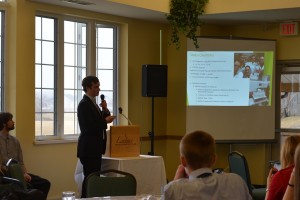Ecosystem Management & Ecological Restoration students present Experimental Design Projects
Testing human urine as a plant fertilizer and measuring the level of contaminants in river water downstream from a former gold mine were just two of the 27 experimental design projects students presented as part of the Ecosystem Monitoring and Assessment course.
There are 100 students in the course, all in the fourth semester of either the Ecosystem Management Technician or Ecological Restoration program. They presented their projects at the Lindsay Golf and Country Club as part of a day-long conference, organized by faculty member Barb Elliot.
The students had to develop a hypothesis, alternate hypothesis and then test out their hypotheses using methods learned in the classroom. They presented their findings to faculty members and their fellow students with the opportunity for questions from the audience.
“I cannot emphasize how important this is,” said Barb. “Students say year over year how the entire experimental design project has helped them build confidence in their skills by applying all the knowledge that they have gained so far in their schooling to the project – both technical and soft skills such as communication, leadership, problem solving, managing conflict, and others. The students discover things about themselves that they never knew, and some find a passion for something – even statistics – that they never knew they had.”
The day is set up as a conference to prepare students for real world work within their field, which often requires public speaking and presentation skills.
“It allows all students to learn about what other teams have done. Because the course is in four different sections, the students do not know what other teams are doing until this day. Exposing the students to a conference-style format also prepares them for third year Ecosystem Management (if they return) where they participate in a conference in Washington D.C., and then plan and present their own ecohealth conference at the end of semester six,” said Barb.
“Being exposed to the idea of a conference or public presentation is important for all students – practice with public speaking builds their confidence at the end of term, just before they head out into the world,” she added.
Faculty member Mike Fraser instructs the students on presentation and public speaking skills in the Career Advancement Techniques course. He emphasized with students the importance of public speaking in their field and told the class they were the best group of public speakers he’d seen to date.
“The ability to articulate in an environment like this is a high demand skill in this field,” he said.
One group presented the project You Reap What you Pee, which compared the growth effects of human urine and commercial fertilizer (they used Miracle-Gro) on the growth of plants.
Because human urine has a similar nitrogen-phosphorus-potassium (NPK) make-up to Miracle-Gro, the group hypothesized that both groups of plants would grow similarly.
Using tomato plants, the students had three groups of plants: one group was fertilized regularly with one part urine, five parts water; a control group that was just watered; and the commercial group, fertilized with 4 litres of water and 5ml concentrate of Miracle-Gro.
The students documented the plant growth then harvested and dried the plants to weigh them.
The results? The urine-fertilized plants were fuller and weighed more than the commercially-fertilized plants. In fact, some of the commercial group suffered nitrogen burn, while the control group plants were small and sparse.
Another group presented their project, the Effects of Deloro Gold Mining Operations on the Moira River Benthic Macroinvertebrates.
The Deloro gold mine near Marmora, Ontario ran for about 100 years from the 1860s to 1960s. The students stated that there had been arsenic found and documented in the Moira River from mine tailings and contamination. Over the years since the mine closure, 15 tons of arsenic has been taken out of the river system – about 80%, said the students.
The students tested benthic macroinvertebrates at three separate river sites and found no significant difference in the diversity of the macroinvertebrates, and their testing showed poor water quality.
Levels of arsenic, cobalt and copper were found, and the cobalt levels exceeded threshold values recommended by Environment Canada, said the students.
Benthic macroinvertebrates are animals without backbones that live in freshwater and are visible with the naked eye, living on the bottoms of streams, river, lakes, and ponds.
They are often used in testing because they are a good indicator of stream health. They are easy to sample, they don’t move around much, and are therefore a reliable gauge of stress effects on the ecosystem.
The students shared their results as well as the challenges they faced in carrying out their projects. Many who completed field tests outdoors, ran into problems with snow and ice due to the unusually cold winter we experienced.
“This was really an excellent year for student projects. People pursued some very interesting, innovative, and personal topics of interest and did an excellent job of incorporating learning into their work. That being said, as the teacher for the course, I learn every year about what I need to put more focus on – and learn more about – for future years,” said Barb.
